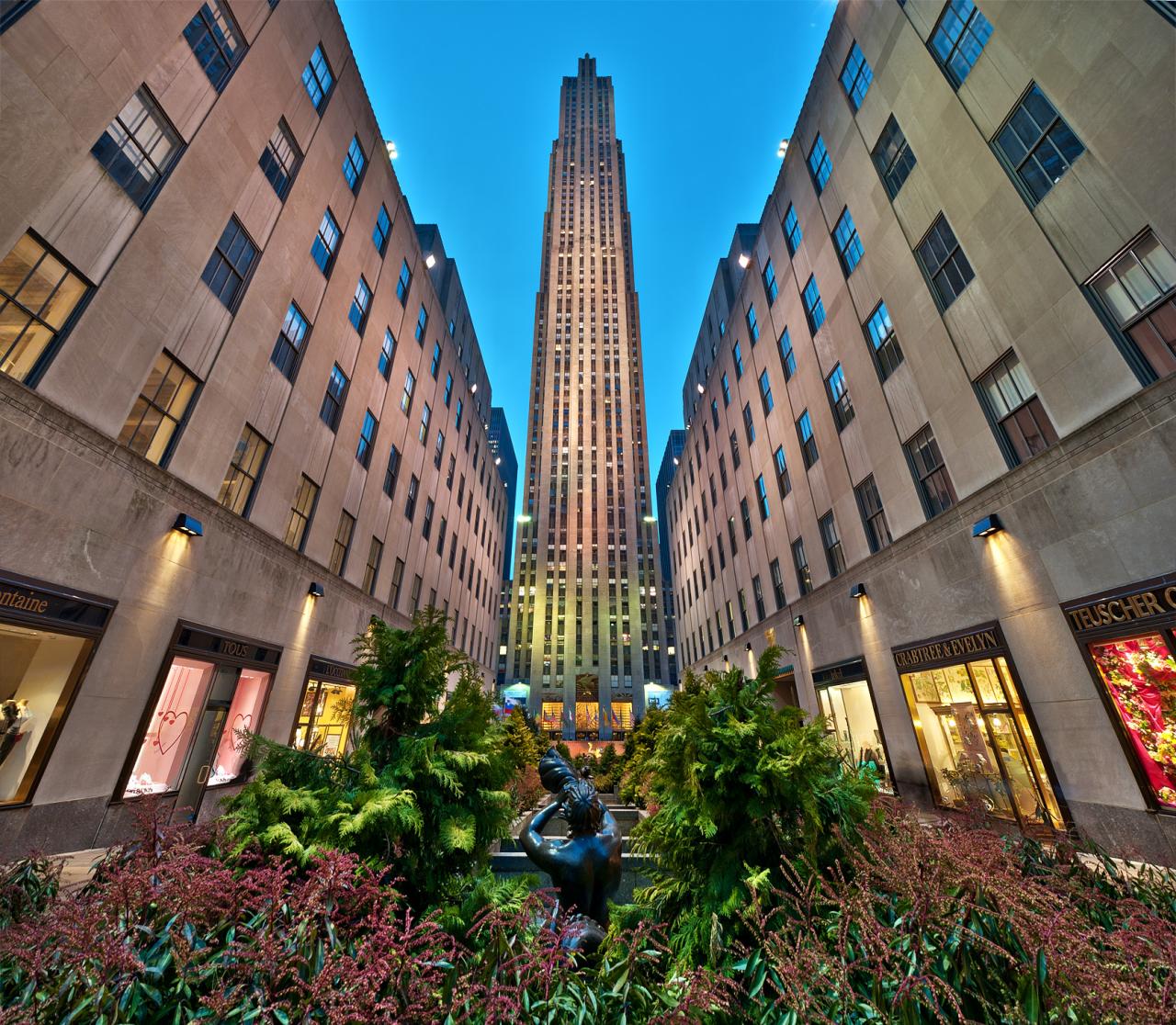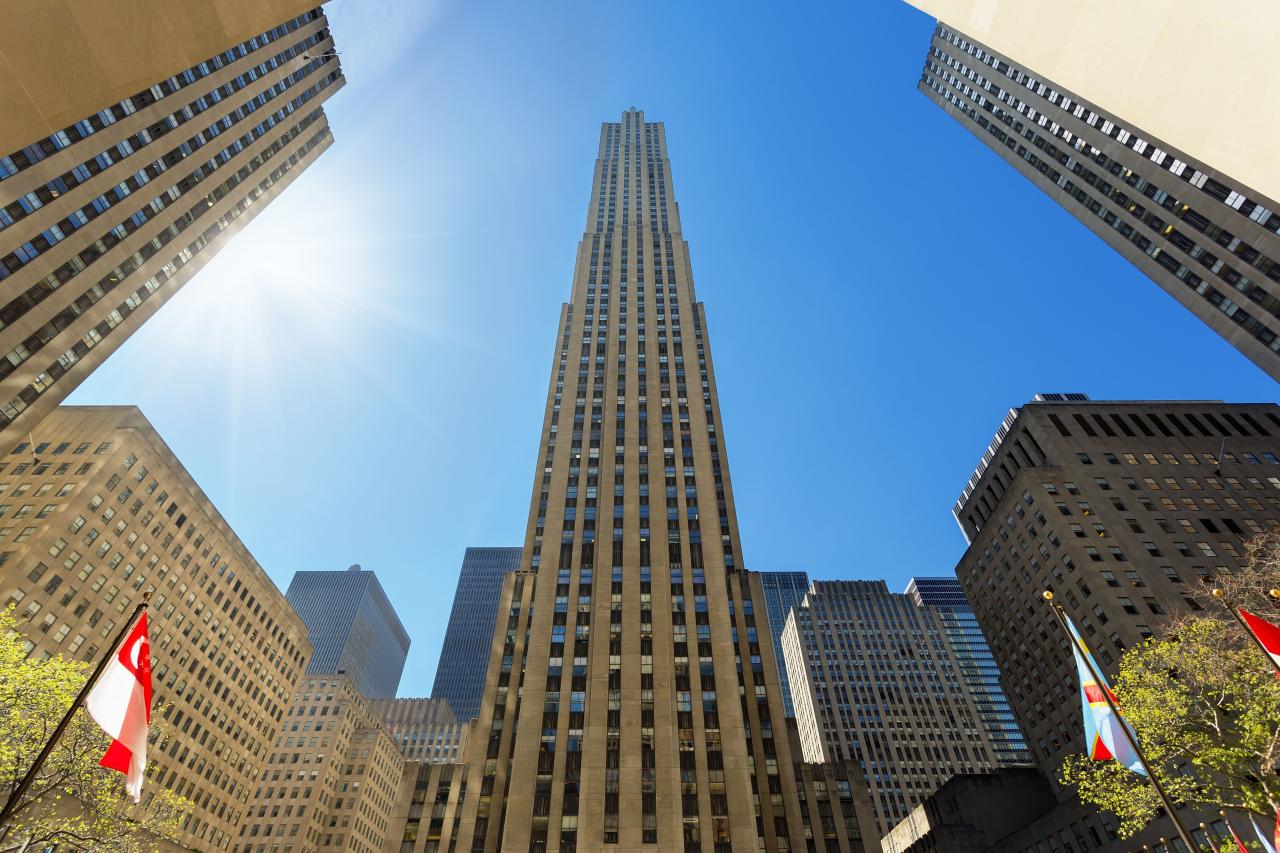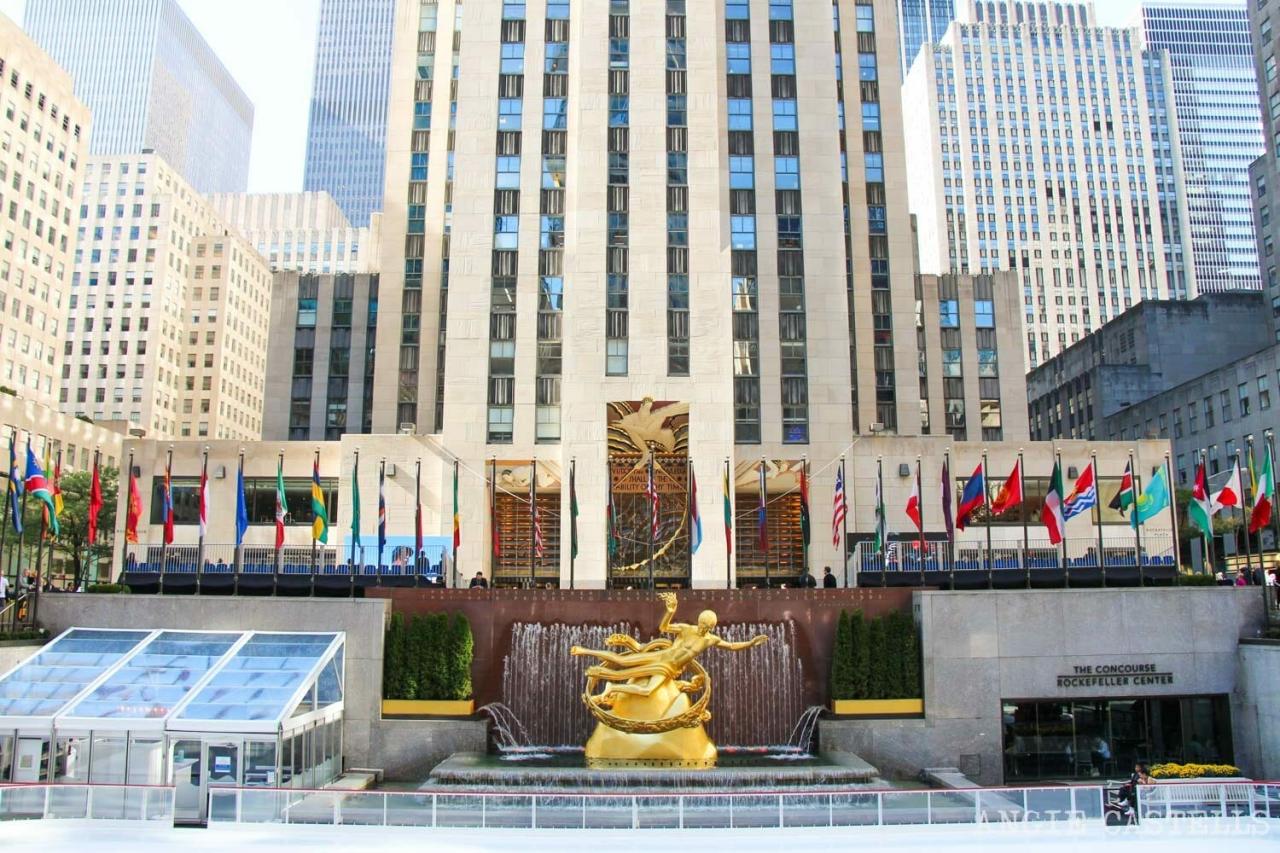Step into the grandeur of Rockefeller Center, a captivating tapestry of architectural brilliance, commercial vibrancy, and cultural significance that has shaped the heart of New York City for nearly a century.
From its inception as a visionary urban development to its enduring status as a beloved destination, Rockefeller Center’s story is a testament to human ingenuity, artistic expression, and the transformative power of architecture.
History and Evolution of Rockefeller Center
Rockefeller Center is a vast complex of 19 commercial buildings covering 22 acres (8.9 ha) between 48th and 51st Streets in Midtown Manhattan, New York City. It was developed by John D. Rockefeller, Jr. between 1930 and 1939.
Rockefeller Center was conceived as a “city within a city”, with its own streets, parks, and amenities. It was designed to be a hub for business, entertainment, and culture, and it quickly became one of the most iconic landmarks in New York City.
Vision and Motivations
Rockefeller Center was the brainchild of John D. Rockefeller, Jr., the son of the Standard Oil magnate John D. Rockefeller. Rockefeller, Jr. was a philanthropist and a visionary who believed that business could be a force for good in society.
Rockefeller, Jr.’s vision for Rockefeller Center was to create a “city within a city” that would be a vibrant hub for business, entertainment, and culture. He wanted to create a place where people could work, live, and play, and where they could experience the best that New York City had to offer.
Challenges and Triumphs
The construction of Rockefeller Center was a massive undertaking, and it was not without its challenges. The project was delayed by the Great Depression, and Rockefeller, Jr. had to personally guarantee the financing to keep the project afloat.
Despite the challenges, Rockefeller Center was completed in 1939, and it quickly became a success. The complex attracted tenants from a wide range of industries, and it became a popular destination for tourists and New Yorkers alike.
Rockefeller Center has continued to evolve over the years, and it remains one of the most iconic landmarks in New York City. The complex has been expanded several times, and it now includes a variety of new buildings and amenities.
Architectural Design and Features
Rockefeller Center’s architectural design is a harmonious blend of Art Deco and Moderne styles. The complex is characterized by its sleek lines, geometric shapes, and lavish ornamentation.
The buildings’ setbacks, a requirement of the 1916 Zoning Resolution, create a series of terraces and plazas that provide ample public space and natural light.
Art Deco Influences
- The buildings feature stylized geometric motifs, such as chevrons and zigzags, which are typical of Art Deco design.
- The use of luxurious materials, such as marble, granite, and bronze, adds to the opulence of the complex.
Setbacks and Public Spaces, Rockefeller center
- The setbacks create a series of terraces and plazas that offer visitors respite from the hustle and bustle of the city.
- These outdoor spaces are adorned with sculptures, fountains, and greenery, creating a welcoming and inviting atmosphere.
Symbolism and Motifs
- The Prometheus statue, located in the center of Rockefeller Plaza, symbolizes the gift of fire to humanity and the triumph of human ingenuity.
- The Atlas statue, perched atop the International Building, represents the burden of the world and the strength to carry on.
Commercial and Retail Offerings
Rockefeller Center is a renowned shopping and dining destination in the heart of Manhattan, boasting an array of retail stores, restaurants, and entertainment venues. Over the years, its commercial offerings have evolved significantly, reflecting the changing tastes and needs of consumers.The center’s retail landscape is anchored by flagship stores of renowned brands such as Saks Fifth Avenue, Kate Spade, and Tommy Hilfiger.
These stores offer a wide selection of high-end fashion, accessories, and home goods, catering to a discerning clientele. In addition, the center houses a diverse mix of specialty boutiques, ranging from jewelry and watchmakers to bookstores and gift shops.Dining options at Rockefeller Center are equally diverse, offering everything from casual eateries to fine dining establishments.
Notable restaurants include the iconic Rainbow Room, which offers panoramic views of the city, and the upscale Todd English Food Hall, which features a variety of culinary options from around the world. The center also hosts seasonal events and pop-up shops, adding to its vibrant atmosphere.The presence of flagship stores and high-end boutiques has significantly enhanced the center’s overall appeal.
These stores not only offer exclusive products and services but also contribute to the center’s image as a luxurious and sophisticated destination. The careful curation of retail offerings has created a synergistic relationship between shopping, dining, and entertainment, making Rockefeller Center a truly immersive experience for visitors.
Cultural Significance and Events
Rockefeller Center stands as a cultural beacon in the heart of New York City. It has played a pivotal role in shaping the city’s arts and entertainment scene, hosting numerous iconic events and performances that have left an indelible mark on the cultural landscape.The Rockefeller Center Christmas tree lighting ceremony is an annual tradition that has become synonymous with the holiday season in New York City.
The tree, adorned with thousands of twinkling lights, has been a centerpiece of the Rockefeller Center Plaza since 1933. The lighting ceremony, which attracts millions of visitors each year, has featured performances by renowned artists and celebrities, further enhancing its cultural significance.Beyond the Christmas tree lighting, Rockefeller Center has also been home to the renowned Radio City Music Hall.
This iconic venue has hosted countless legendary performances, including the Rockettes, Frank Sinatra, and The Beatles. Radio City Music Hall’s Art Deco design and opulent interior have made it a beloved landmark and a symbol of New York City’s vibrant entertainment scene.The ice skating rink at Rockefeller Center is another beloved attraction that has become a cultural icon.
The rink, which opened in 1936, has been featured in numerous films and television shows, and has become a popular destination for both locals and tourists. The rink’s picturesque setting, surrounded by the Art Deco buildings of Rockefeller Center, creates a magical atmosphere that has captivated visitors for generations.Rockefeller Center’s contributions to New York City’s cultural scene extend beyond these iconic events and venues.
The center has been home to numerous art galleries, theaters, and performance spaces, providing a platform for emerging and established artists alike. It has also been the setting for countless film premieres, fashion shows, and other cultural events, further solidifying its status as a hub for creativity and innovation.Through its diverse offerings and unwavering commitment to the arts, Rockefeller Center has played an instrumental role in shaping New York City’s cultural identity.
It has become a beloved destination for locals and tourists alike, a place where memories are made and cultural experiences are shared. As the center continues to evolve, its cultural significance is sure to endure for generations to come.
Impact on Urban Planning and Development: Rockefeller Center
Rockefeller Center has had a profound impact on the surrounding neighborhood and New York City as a whole. It was one of the first large-scale urban renewal projects in the United States, and it helped to set a new standard for urban planning and development.The center’s design was influenced by the City Beautiful movement, which emphasized the importance of creating beautiful and orderly cities.
The center’s buildings are arranged around a central plaza, which is surrounded by gardens and fountains. This design creates a sense of openness and grandeur, and it has become a popular destination for tourists and locals alike.Rockefeller Center has also played a major role in shaping New York City’s skyline.
The center’s towers are among the tallest buildings in the city, and they can be seen from miles around. The center’s design has also influenced the design of other buildings in the city, and it has helped to create a more cohesive and unified skyline.The center has also had a significant impact on real estate development in the area.
The center’s presence has made the surrounding neighborhood more desirable, and it has led to the construction of new luxury apartments and condominiums. The center has also helped to attract new businesses to the area, and it has created a thriving commercial district.Finally, Rockefeller Center has had a major impact on tourism in New York City.
The center is one of the most popular tourist destinations in the city, and it attracts millions of visitors each year. The center’s popularity has helped to boost the city’s economy, and it has made New York City a more popular destination for tourists from around the world.
Influence on Urban Planning Principles
Rockefeller Center has had a significant influence on urban planning principles. The center’s design emphasizes the importance of creating open and inviting public spaces. The center’s plaza is a popular gathering place for people of all ages, and it has helped to create a sense of community in the surrounding neighborhood.The center’s design also emphasizes the importance of mixed-use development.
The center includes a mix of residential, commercial, and cultural uses, which helps to create a vibrant and diverse neighborhood. The center’s success has helped to demonstrate the benefits of mixed-use development, and it has led to the adoption of similar principles in other cities around the world.
Sustainability and Environmental Initiatives
Rockefeller Center has been at the forefront of sustainability efforts, implementing various green building practices, energy efficiency measures, and waste management programs to reduce its environmental impact.
The center’s commitment to sustainability is evident in its LEED Platinum certification, recognizing its exceptional environmental performance.
Green Building Practices
- The use of energy-efficient lighting systems, including LED fixtures and daylight harvesting.
- Installation of high-performance windows and insulation to reduce energy consumption.
- Implementation of green roofs and rainwater harvesting systems to manage stormwater runoff.
Energy Efficiency Measures
- The center utilizes a combined heat and power (CHP) system, generating electricity and heat from a single source, improving energy efficiency.
- Variable-frequency drives (VFDs) are employed to optimize the performance of HVAC systems, reducing energy usage.
- Smart building technologies monitor and control energy consumption, allowing for real-time adjustments.
Waste Management Programs
- Comprehensive recycling and composting programs divert waste from landfills, promoting resource conservation.
- Single-stream recycling bins make it convenient for tenants and visitors to recycle.
- The center has partnered with local organizations to donate surplus food and materials, reducing waste.
Epilogue
Rockefeller Center stands as a timeless symbol of New York City’s indomitable spirit, a testament to the enduring power of architectural innovation, and a vibrant hub where commerce, culture, and community converge.
Detailed FAQs
When was Rockefeller Center built?
Construction began in 1930 and was completed in 1939.
Who designed Rockefeller Center?
Raymond Hood, along with a team of architects, designed Rockefeller Center.
What is the tallest building in Rockefeller Center?
The tallest building in Rockefeller Center is the GE Building, which stands at 850 feet tall.
What is the most famous attraction in Rockefeller Center?
The most famous attraction in Rockefeller Center is the Rockefeller Center Christmas Tree.



